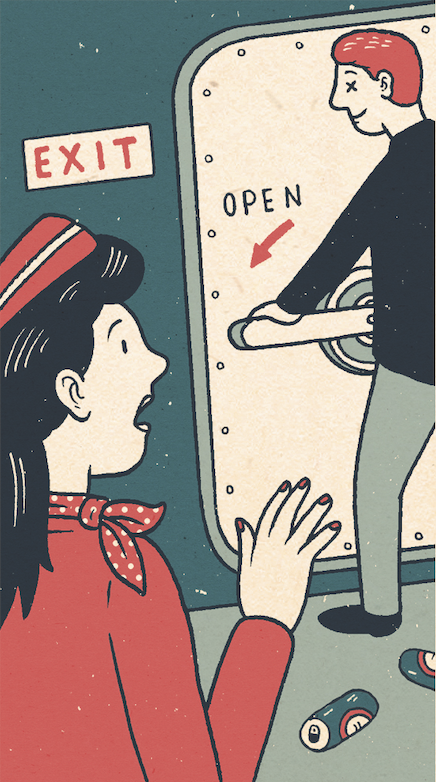Reports of unruly or disruptive passengers have been escalating. According to IATA, in 2017, there was one unruly passenger incident for every 1,053 flights. Between 2007 and 2017 there were more than 66,000 incidents reported to IATA. IATA’s statistics from 2014 suggested a meteoric rise in disruptive incidents (8,217 incidents – 43% more than the 2013 numbers), and 40% of airlines had experienced at least one incident where diversion was required.
These statistics were captured in IATA’s STEADES (Safety Trend Evaluation, Analysis and Data Exchange System), and cover eight types of disruption, ranging from using cigarettes or drugs, verbal or physical confrontations, interfering with crew or refusing to comply with instructions, sexual misconduct and other “riotous behaviour”.
Recent examples of bad passenger behaviour include a passenger with Jet2 who sparked a hijack alert – and the launch of two after allegedly trying to open the emergency exit mid-air. Jet2 had another passenger incident in January which required a flight from Tenerife to Belfast to be diverted (video here). In fact Jet2 has some bad luck in this area. Another airline with a few incidents on its books is Irish LCC, Ryanair, with one recent case being a fistfight in the cabin.
But is passenger behaviour getting worse, or is it just being reported more frequently by crews and in the media? The answer likely lies somewhere in the middle. It’s no secret that passengers view air travel as being less pleasant than in the past, with more queues, more frustrating security, smaller seats, less legroom, fewer amenities, worse service and unfriendlier crews – and all for more money.
The realities – that ticket prices have fallen in real terms over the past 20 years (US domestic ticket prices adjusted for inflation have come down nearly 15% since 1995), that extra-legroom economy seats on US airlines and proper international premium economy on non-US carriers are equal or superior to the ‘good old days’ – are less relevant to passenger behaviour than the perceptions.

And if pitch and service were the panacea, then the 34in-pitch economy standard on JetBlue and Korean Air would suggest those airlines should have fewer incidents. Yet widely publicised incidents involving JetBlue cabin crew member Steven Slater and Korean Air former senior VP of inflight service Heather Cho Hyun-ah spring to mind. However, a lack of standardised reporting means data-driven comparisons across airlines are not possible.
Clearly the increase in the number of devices capable of recording video means that we see more disruptive incidents in the news. It’s a lot easier for a tabloid newspaper, Gawker site or Buzzfeed contributor to hang a story on pictures of an Icelandair passenger taped to his seat or a YouTube video of a passenger going bonkers than it is on just a description.

Flight attendants may also be more willing to report incidents than in the past. Factors contributing to this could be the post-9/11 focus on cabin security, optimisation of cabins to maximise the passenger-to-flight-attendant ratio, wider societal changes making harassment less acceptable, and even much maligned occupational health and safety regulations.
All incidents have the potential to cause damage to the airline”
“Regardless,” says threat management specialist, Totti Karpela, who has worked with multiple airline crews, “incidents will also be extremely unpleasant and sometimes even traumatising for other passengers. Naturally, all incidents have the potential to cause damage to the airline – besides diversion and delays – once media and especially social media get hold of the incident and all of a sudden 20,000 people are retweeting or sharing information on Facebook.”
A well-documented incident that caused a PR nightmare for United Airlines was of course the 2017 incident of Dr David Dao being dragged off an overbooked flight.
So what’s to be done? The first step – to ensure that enforcement of the rules is possible regardless of
where they are broken – is currently underway.

The Montreal protocol
Montreal Protocol 2014 provides jurisdictional updates to the 1963 Tokyo Convention. Over 50 years after the Tokyo Convention was promulgated, it’s clear that the world has changed. ICAO, the UN body concerned with civil aviation, began a review of the Convention in 2009, resulting in the Montreal Protocol of 2014.
The very first section of the preamble to the Montreal Protocol, currently out for ratification to member states, is clear about the problem: “States have expressed their concern about the escalation of the severity and frequency of unruly behaviour on board aircraft that may jeopardise the safety of the aircraft or of persons or property therein or jeopardise good order and discipline on board.”
Most of the 2014 Protocol deals with international and multinational jurisdictional issues to ensure that all states are able to prosecute disruptive passengers on inbound aircraft. It also grants some additional specific legal powers of restraint to aircraft commanders, and makes some clarification around the types of disruption that should be considered unlawful.
Yet the jurisdictional issues within states may be just as problematic as between them, and many states have enacted additional national regulations to fill the gaps of the Tokyo Convention to provide a relatively wide scope for action to be taken about disruptive passengers following an incident.

A US FAA spokesperson told Aircraft Interiors International: “It is up to the airline to decide if they want to report a case to the FAA. The pilot in command can make that call. They can also choose to divert, if necessary. If a case is egregious, they may request law enforcement support once they land. In that case, the passenger would be handled by local or federal law enforcement. Those cases are not in the FAA’s database. Those cases would be criminal and a local US District Attorney would decide if there was a case to prosecute. The US Department of Justice does not have national stats for those cases. In addition, security violations are handled by the TSA.”
That’s a possible eight sets of lumbering bureaucracy, covering a complex Venn diagram of jurisdiction, even within a single country. Yet the laws themselves seem fairly clear, even if enforcement is complex. With few important changes in the laws in recent years, and certainly nothing new that would seem to trigger a huge spike in reports of disruptive passengers, it can’t just be a legal gap.
As an example of the legislation around disruptive passengers, the UK’s Air Navigation order makes it a criminal offense to endanger the safety of an aircraft in any way (Article 137), and specifically proscribes being drunk on board an aircraft (Article 139), smoking on board an aircraft (Article 140) and disobeying the commands of the aircraft commander (Article 141). “Breaching any of these rules can result in a criminal prosecution and a custodial sentence on conviction,” the UK CAA told Aircraft Interiors International.
In the USA, Federal Aviation Regulations 91.11, 121.580 and 135.120 cite that, “No person may assault, threaten, intimidate or interfere with a crew member in the performance of the crew member’s duties aboard an aircraft being operated.”
International regulations are harmonized by ICAO, with further regulation regionally. As the UK CAA put it to us: “All EU carriers operate to an equivalent level as they are required to comply with EASA Air Operations regulations. As for non-EU carriers, there are no particular agreements in place, although ultimately all international aviation authorities follow guidance and policy set by ICAO.”
With ICAO’s work currently focusing on ratifying the Montreal Protocol, airlines themselves – perhaps with leadership from IATA – need to develop and iterate best practices to deal with disruptive passengers.

Prevention is key
IATA’s Guidance on Unruly Passenger Prevention and Management recommends that airlines, “develop a preventive strategy based on: increased awareness of passengers and among all employees of how the air carrier will respond to disruptive acts, the implementation of a Zero Tolerance policy, and the type of response and consequences of unruly behaviour”.
The focus of company policy should be on acting on early signs of unruly behaviour”
“Prevention,” IATA says, “is the most effective mitigation measure to unruly passenger incidents and could be promoted as the responsibility of employees throughout the entire organisation. Often unruly behaviour is not the result of a single event but rather the effect of a series of events that build up. Early signs of potential unruly behaviour can often be observed. The focus of the company policy should be on acting on these early signs, rather than dealing exclusively with escalated events.”
Problematically, the airline industry is focusing on reducing the number of passenger touchpoints. Even today, a passenger boarding a Lufthansa flight in Frankfurt using a mobile boarding pass or kiosk and the airline’s self-boarding gates may not even encounter an airline employee until door 1L.
 Increased regulation of airport service of alcohol to dissuade overconsumption could also make sense. An FAA spokesperson told us, “The FAA has no regulatory authority over airport businesses.” The situation in the UK is the same: “We have no involvement in regulating the sale of alcohol in airport terminals,” said a CAA spokesperson. “It is down to local authorities.”
Increased regulation of airport service of alcohol to dissuade overconsumption could also make sense. An FAA spokesperson told us, “The FAA has no regulatory authority over airport businesses.” The situation in the UK is the same: “We have no involvement in regulating the sale of alcohol in airport terminals,” said a CAA spokesperson. “It is down to local authorities.”
Airlines also have a responsibility: several have quietly ceased or modified their duty-free sales on problem routes (Bali-Australia, for example). Virgin Atlantic recently changed its alcohol announcement, with a spokesperson confirming: “We have been making this announcement for many years. This was about Virgin Atlantic being proactive with our passengers.” The new announcement states: “We’d like you to enjoy your flight, so bear in mind that we only serve alcohol in moderation. Please don’t be offended if we stop serving you – and of course this means you can’t drink your own supply.”
Airlines’ responsibility also extends to the way they brand themselves and present their crew. From the “Bring on the women!” comment from Nok Air’s CEO when asked to pose for photographs, to the plethora of advertising using (exclusively female) sexualized models posing as flight attendants giving flirty glances in come-hither poses, if airlines don’t set a respectful tone before passengers board then how can they expect passengers to maintain one on the aircraft?
Airlines need to take disruption seriously, and set expectations as part of their brand”
Frequent flyers can be some of the worst offenders. “Some of the Marco Polo Club members think they
can do things to us because they are privileged and we somehow allow it. They think it is part of their privilege. Afterward, they believe they can apologise and everything is settled,” Cathay Pacific flight attendant union official Michelle Choi told the South China Morning Post. Could the three global alliances take a stand here with existing systems? Sharing information about disruptive passengers is likely to reap benefits – not least because if there is a single list then passengers might modify their behaviour to avoid future consequences, not least to their points balances.

A wider information-sharing system about passengers who have been disruptive on aircraft has been mooted – and dropped – previously. “We are not aware of any specific proposals. A shared database of ‘problem passengers’ has been discussed in the past. However, there are possible data protection issues that may need to be resolved before such a system could be set up,” a UK CAA spokesperson commented. A spokesperson for the FAA was also unaware of any activity to share information about passengers. IATA’s STEADES incident database is anonymized, so carrier-by-carrier comparisons are not possible.
Regardless, it’s clear that airlines need to take disruption seriously, and set expectations as part of their brand. With the amount carriers spend on advertising annually, it would certainly help show that their money is where their mouths are.
How to deal with common passenger behaviour issues
What to do when: a passenger becomes violent:
Crew should first ensure that the fasten seatbelt signs are on, to stop other passengers interfering or bystanders getting into harm’s way, says threat management specialist Totti Karpela. Spoken or written warnings might not be suitable, depending on how quickly the particular event has developed. Crew can command a passenger to sit down or lie down on the floor. If airline policy permits, crew can enlist the aid of willing able-bodied passengers to assist them. Restraining devices including – but not limited to – handcuffs can also be used. “I have rolled one handcuffed kicking, hitting, biting and spitting passenger into two blankets and taped him to resemble a ‘cigar’ or ‘worm’,” Karpela told Aircraft Interiors International.
What to do when: a passenger commits sexual harassment or assault:
The first step is to separate the two parties, reseating at least one party, ideally to the opposite end of the aircraft, Karpela explains. Witnesses should be identified and facts ascertained. In the event of a more escalated sexual incident, ensure that the police will have any evidence. Spoken warnings can be used in incidents that are less escalated, for example the touching, slapping or pinching of another passenger’s or crew’s buttocks. The police can also be informed – nonconsensual sexual contact is often viewed as a criminal matter.
What to do when: a service dispute turns serious
In the ‘knee defender’ type of incident over seat recline, for example, crew should consider whether de-escalation could take place without an audience, potentially in a galley or other area, Karpela says. Ensure other crew members are aware of the situation and at least one other crew member is assisting. If other able-bodied passengers are permitted to assist under airline policy, ensure they are ready to act. Approach the situation in a professional and objective way, without bias to one side or another. Remember that calm people create calm results, and that you are on a stage: most passengers will follow your response and some will likely record it. Ensure both parties feel they have been listened to. Repeating what has been said will demonstrate that you are listening. It rarely hurts to apologize for the inconvenience to both parties – or to thank them for cooperation at the end.
What to do when: a passenger appears drunk
If the aircraft is in flight, says Karpela, check the passenger’s consumption of alcohol and consult with the airline’s alcohol consumption checklist. If the behaviour fulfils the criteria to stop serving alcohol, do so. Ensure the entire crew is aware of the passenger and that he or she will not be served further alcohol, including by friends, the crew in the galley or from their own supplies. Offer non-alcoholic drinks or other options, such as food or sleep, for the remainder of the flight. Remind the passenger of what’s in it for them: feeling better once the drinking stops, a better chance of clearing immigration and airport security at the destination, and a lower chance of meeting with law enforcement on arrival. Consider a spoken warning and, if necessary, a written warning by the aircraft commander. Once compliant, thanking the passenger for cooperation can be very effective.






